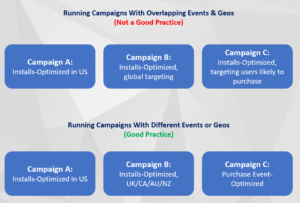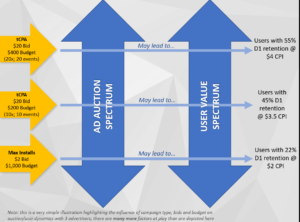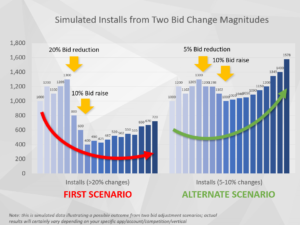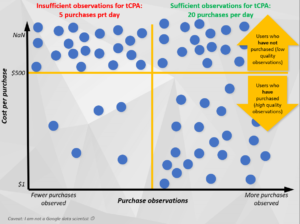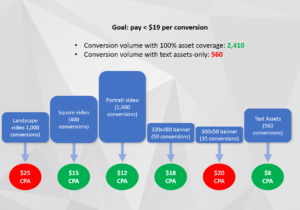Incipia blog
Understand Google Universal App Campaigns With 5 Diagrams
Having a hard time getting UACs to work properly? Read this post to increase your understanding of how UACs operate, and which best practices are critical to success.
Definitions
- UAC - universal app campaign (Google AdWords mobile app advertising campaign type)
- tCPA - campaign optimized for a target cost per action/event
- Max installs - campaign optimized for a target cost per install only
- Max installs advanced - campaign optimized for a target cost per installs firs, but users who are likely to complete the specified event second
- Learning period - the first 7 days of a campaign's lifetime, during which it sets an understanding of which users to target and how much to pay for their actions
UAC Pointer #1: Don’t run multiple instances of the same event targeting campaign in the same geography.
While it may be tempting to try to segment campaigns into different geographies or by different bid/budget, this act by and large is not advantageous and will actually harm performance.
By running multiple campaigns with the same objective in the same geographic area, you will cause the campaigns to compete internally against one another, skewing serving of impressions. This practice follows similar logic to the web world, where splitting keywords into different ad groups/campaigns split impressions/clicks/conversions, making it frustrating to maintain accurate reporting.
In the world of UAC and algorithmic marketing, the impact of competing campaigns is even more significant and detrimental to campaign health. Sufficient data is vital for UAC targeting algorithms; since running multiple campaigns causes data to be split between each campaign, competing campaigns hinders the ability of each campaign’s targeting algorithm to gather data.
That said, running tCPA purchase optimized campaign and max installs together is okay, as are two different tCPA events, such as a tCPA purchases and tCPA registrations campaign, so long as they do not target users of highly similar profiles.
UAC Pointer #2: Commit to appropriate campaign types and budget:bid ratios to acquire the right type of user.
Using a campaign whose objective is to drive purchases is the best move for acquiring users known to be likely to make purchases; as a result, these users will generally cost more than users only known to be likely to install, but have much higher purchase rates.
Using a campaign whose objective is to drive installs is the best move for acquiring users only known to be likely to install; as a result, these users will generally cost less than users known to purchase, but have lower purchase rate.
Not only is it important to keep the above in mind, but it is also important to remember that bids and budgets are an important influence on your campaigns’ ability to acquire users of different qualities and scale. Recall how UAC campaigns require enough data to power their target algorithms; the implications of your bid:budget ratio play out in the concept that the algorithms need lots of data to function properly.
This also means that if your app is able to convert more events per user, your bid:budget ratio can be lower. The most important factor is the number of events, and using higher budgets is the easiest way to ensure you are feeding the algorithms enough data.
Keep in mind the following rules of thumb for bid:budget ratios:
- Max installs optimized budgets should be 100-200x your bid
- tCPA budgets should be 10-20x your budget
UAC Pointer #3: Avoid making too large of bid or budget changes.
Making large bid changes is not good practice with UACs, as this can throw off the smooth progress of the targeting algorithm, resulting in big swings in performance (in both installs volume and CPA). Conversely, smaller changes result in more consistent performance and fewer wild swings.
Again from a data perspective, the goal of the algorithms is to try to acquire users whose acquisition costs back out to whichever target CPA you set, by adjusting the ultimate bid submitted to the auctions, based on performance actuals. The algorithms require enough data to be able to do this task properly. By making large bid changes, you will force the algorithms to push into new areas of the auctions where the pricing and user quality dynamics are different, and due to this, reset the learning period. Not only does this require the algorithm to re-assess what the optimal bidding strategy is (causing swings in performance again), but for significant bid reductions, empirical evidence shows that the algorithms tend to over-correct, submitting more conservative bids to the auctions and causing the user quality to decrease, even if the cost per acquisition improves.
Moreover, from our experience algorithmic ad auctions are very trending-oriented, meaning that performance is self-virtuous, and negative performance begets more negative performance, and vice versa. Conservative bids beget a worse auction score, which begets an even worse auction score, which continues to impact your campaigns even if you return the bid to its normal level. In some cases, campaign volume can be completely destroyed and the entire campaign must be restarted.
Manage the auction dynamics appropriately by only making changes within 20% every 100 installs, or for best results 5-10% at a time.
Especially so, try not to make changes in the first 7 days learning phase of a campaign – this is a non-skippable phase wherein the algorithm is exploring different bid levels, and if you change your bid too significantly, it can reset the learning phase or kick the campaign off with poor learnings. Your target CPA is the ceiling price and also a goal, so the algorithm bids higher and lower within this ceiling price in order to learn which bid levels produce the best results. Performance does improve significantly after a successful learning phase, so be aware that the learning phase should be a bit more volatile than you may be comfortable with.
UAC Pointer #4: Only run tCPA event-optimized campaigns against events for which you have enough event data.
Are you sick of hearing about how these campaigns need enough data to function? While frustrating to many digital marketers used to maintaining full control and knowledge of campaign mechanics, the best practice to scaling UACs is often to let them learn with as much budget as can be allocated. Additionally, when they do get enough data, it’s pretty incredible what they can accomplish in terms of scale and ROI.
Pointer #4 beats the drum on the data requirement. Ensuring that you have sufficient event volume before kicking off an event-optimized campaign is crucial. This is because events are much more nuanced and the conversion rate of install to event is often only 1-10%, meaning that the algorithms simply require more data to figure out what types of users will convert. Every user who is acquired helps to tune the algorithms, but users who don’t convert events (e.g. purchase) offer less value than those that do.
Also, at the start of a campaign, the ratio of users who purchase to those that do not will be much lower than after the campaign has been running for some time (recall the learning phase concept), causing performance to improve over time. An analog in the web search world is B2B marketing; you try optimizing search terms with years-long conversion cycles, or within the first week!
The best practice is 10-30 events/day, but optimal performance comes from having even higher event volume. If you don’t have enough volume, try a max installs advanced-optimized campaign (optimized for people likely to complete that event) first. It’s sort of like a tCPA campaign with training wheels on, optimizing for install volume while at the same time trying to acquire users with a high propensity to complete your target event. This campaign is different in that it will not be hindered by having insufficient (because its targeting goal is primarily to acquire installs), but it will, when possible based on auction dynamics, work to acquire users known to be likely to complete your event.
UAC Pointer #5: Invest in a wide asset dimension coverage.
Giving UACs enough assets to uncover which perform the best has been proven to help improve performance overall due to the U in UAC. The U, which stands for universal means that ads may serve across the universe of Google AdWords inventory, which amounts to a staggering number of placements and types of inventory (and growing by the month!). Each dimension of an asset (e.g. a portrait vs landscape video) will make your ads eligible to show across different inventory in the Google universe, and each inventory has different auction and user quality dynamics.
For example, portrait orientation videos serve mostly everywhere videos can serve, except for YouTube, which requires landscape orientation videos. Users on YouTube are often more pricey, but higher quality than other video inventory sources. By adding landscape, you enable your ads to show in YouTube, thus influencing the ability of your UAC algorithm to optimize towards your goal.
If no image/video assets are explicitly uploaded to your UACs, they will Frankenstein metadata from your store listings into image/video assets; this cannot be disabled and the only way to influence which assets your ads use is by uploading image/video assets.
Not only do assets influence your performance via inventory dynamics, but the act of adding a larger quantity of assets has been proven to help the algorithms try more assets and ultimately zero in on the favorites and give up underperformers faster. Maybe it’s Google’s method of benefiting you for following best practices; or maybe Google’s machine learning has developed a personality, ironically like a true creative type who will only put forth their best work if they are offered the full autonomy to do so. Either way, fill up your asset slots for best performance.
Thanks for reading - stay tuned for more pointers and best practices on managing Google UACs!
Be sure to bookmark our blog, sign up to our email newsletter for new post updates and reach out if you're interested in working with us to optimize your app's ASO or mobile marketing strategy.
Incipia is a mobile marketing consultancy that markets apps for companies, with a specialty in mobile advertising, business intelligence, and ASO. For post topics, feedback or business inquiries please contact us, or send an inquiry to projects@incipia.co
Categories
Tags:
- A/B testing
- adjust
- advertising
- adwords
- agile
- analytics
- android development
- app analytics
- app annie
- app development
- app marketing
- app promotion
- app review
- app store
- app store algorithm update
- app store optimization
- app store search ads
- appboy
- apple
- apple search ads
- appsee
- appsflyer
- apptamin
- apptweak
- aso
- aso tools
- attribution
- client management
- coming soon
- design
- development
- facebook ads
- firebase
- google play
- google play algorithm update
- google play aso
- google play console
- google play optimization
- google play store
- google play store aso
- google play store optimization
- google uac
- google universal campaigns
- idfa
- ios
- ios 11
- ios 11 aso
- ios 14
- ios development
- iot
- itunes connect
- limit ad tracking
- ltv
- mobiel marketing
- mobile action
- mobile analytics
- mobile marketing
- monetization
- mvp
- play store
- promoted iap
- promoted in app purchases
- push notifications
- SDKs
- search ads
- SEO
- skadnetwork
- splitmetrics
- startups
- swift
- tiktok
- uac
- universal app campaigns
- universal campaigns
- user retention
- ux
- ux design
